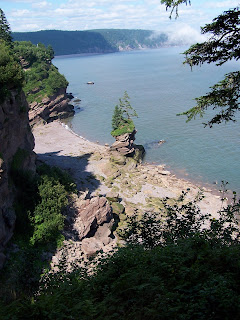Sunday, September 2, 2007
A Wonderful Trip
I would like to thank Fund for Teachers for this opportunity. I am excited about this school year and can't wait to share all that I have learned.
Sunday, August 12, 2007
Tidal Bore Rafting!!!
HOLDING ON!!!
I almost fell out twice, but managed to stay in by gripping the ropes behind me!
Saturday, August 11, 2007
Parrsboro and Joggins, Nova Scotia
Next I drove on a very scenic route to Joggins, home of the Joggins Fossil Cliffs. (See a video of the drive on the right) This site is famous for the fossils of the first known reptiles that lived 100 million years before the dinosaurs roamed the earth. I spent several hours searching for fossils and "rock-hounding." Check out the video on the right to see what the rocks look like at the fossil cliffs.
Oh, I think I may have found some fossils, but I am not sure. I will have to reasearch them on the internet.
The Coast of New Brunswick
Next, I stopped at Cape Enrage. This lighthouse is one of the oldest in New Brunswick. However, now that lighthouses really are not needed, this lighthouse and the surrounding buildings were abandoned. In the early 90’s several high school students and some sponsors decided to save Cape Enrage. They found financial sponsors and the high school students restored all the buildings. Now, high school and college students run the buildings, which include a small restaurant and gift shop. The Cape is called “enrage” because when the tides come in, the rocks at the bottom of the cliffs cause the water to swirl and turn violently, giving an enraged look! Here are some pictures from the area:
The last stop was at the Hopewell Rocks. This is one of the main tourist attractions of the Bay of Fundy, and you will see why from the pictures. This area of red sandstone has been easily eroded away over millions of years, and still continues to erode today. Check out the pictures of the remnants from the large-scale erosion:
Thursday, August 9, 2007
Saint John, New Brunswick
I spent the first part of my day at the New Brunswick Museum. This museum has a great marine and geoogy section. The display I found most impressive was that of the whales. Check out these pictures:
Skeleton of a Whale
Skull of a Whale
While at the museum, I also saw some really cool fossils. Here are some of my favorites:
My day ended with a visit to the Reversing Falls. This is was an awesome tour where I learned why the Saint John River actually reverses its flow of water during high tide. My tour guide for this boat tour was a middle school teacher, so we had lots to talk about when it came to comparing schools!!
Check out the videos to the right labeled "Reversing Falls."
Tuesday, August 7, 2007
St. Martins, New Brunswick
The beach at the sea caves is made up of smooth, rounded rocks; another sign of the tremendous amount of erosion that takes place at the Bay of Fundy.
Here you can see how the rocks erode from the large wall of conglomerate rock.
(Click on pictures for a lrger view of the image)
I also visited the Fundy Trail. This newly created trail has lots of hiking and biking trails. The most interesting formation is the "Flower Pot" rock. The rock all around the flower pot has eroded away leaving just this part still standing, probably because of the roots embedded in that section of the rock. Check out these amazing pictures:
Here is a picture of me walking for miles and miles down the road to find my rental car after getting lost on the Fundy Trails. I definitely got my exercise for the day!!


















































